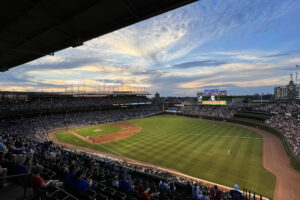When Vegas Golden Knights owner Bill Foley let slip that the idea of a Canadian NHL division had been proposed, no one should have been surprised. It’s an idea that has been around for decades, though back in the ’80s it was for financial reasons. But there is more to the league than their top-tier. For those players who don’t quite make the cut, the primary option has always been the AHL. There are a lot of players who don’t qualify for juniors anymore, and 21-year-old prospects have to play somewhere. If teams wanted their players to be completely safe, they’d send all the teams to South Korea for the season. This might not be the most practical choice, so what is?
AHL Options
So what about their AHL teams? If the NHL relies on the gate more than any other of the Big-Four team sports in North America, the AHL does even more so. While they have affiliations with NHL teams, AHL teams are still businesses. And without fans in the seats, those businesses shut down when the NHL did. Unlike the NHL, they didn’t reopen for playoffs. This caused a cascade effect for their parent clubs, specifically with those players who are almost good enough. It’s not just prospects, but the veterans who are expected to guide those prospects, the older ‘first-ones called’ keeping in shape, those recovering from injury or absences, etc. The AHL is an integral part of the NHL. Obviously, they want to continue next season, and the NHL wants them to continue next season.
But the cross-border quarantine still applies to athletes — yes, even hockey players. This isn’t just an inconvenience, it can be crippling. That’s not just “not skating with the club” but not working out, not practising in a public rink, etc. A player who didn’t make the team at the start of the season is hardly going to improve after a week of waiting.
The Edmonton Oilers, Calgary Flames, and Vancouver Canucks all have their feeder teams in the United States. That’s Bakersfield, Stockton, and Utica respectively. Any player joining the NHL club (or heading downwards) will need to wait in quarantine for two weeks. Even if a deal is struck, it’s likely not going to be less than seven days. The same problem will happen to Canadian clubs going South for the year — but with the advantage of Laval (Montreal Canadians), Toronto (Toronto Maple Leafs), Belleville (Ottawa Senators), and Manitoba (Winnipeg Jets) being able to play against the rest of the AHL without crossing the border.
AHL Option 1: No Change or Moving Canadian Teams to the US
One alternative is to allow the NHL teams to carry more non-roster players. Normally the limit is 23, but when one player gets called into service, there ideally will be another behind them quickly, just in case. It’s not all that uncommon for two players in the same position to get injured within days of each other. If that limit is increased to the same numbers that were in the NHL bubbles, it would relieve that pressure.
The bubble limit was 31 players — which is reasonable, given the time frame and risks involved. But if teams took their best prospects, two things would happen and neither is good. First, their AHL teams would be considerably weaker. NHL teams will want their best players on hand to join them, after all. Down on the farm, however, that means their stars are gone, making for a rough year. A universal talking point among managers is that they don’t want their kids to develop in losing programs if they can help it. The other negative is those players are called up… to sit. Yes, they’ll be practising against NHL-level teammates, which is great. But they won’t be playing in game situations unless called in, and even then they’ll likely get a few minutes. Eight minutes a game isn’t really developing skaters as well as twenty minutes a night would.
AHL Option 2: Move US Teams North
Just the Canadian NHL teams’ feeder clubs, obviously. Though if the American clubs want to consider it, Canada certainly has rinks to spare.
Doing this option gives rise to another question: near or far? Winnipeg’s club is right in town, so they won’t want to go anywhere. Same holds true for Toronto, and Ottawa’s farm is a three-hour drive. Montreal’s club currently sits in a COVID-19 “hot zone” but that may not be the case by the time the league restarts. Having them right across the Prairies River is right handy, but even if they move a bit West it’s not much of a hardship.
Vancouver has used Utica for a specific reason: it’s cheaper. Travel is much shorter when you’re close by, and most of the AHL is clustered in the East. They also play more games than the Pacific Division does (76 to 68), but that’s a minor consideration. Edmonton’s and Calgary’s California-based clubs are closer to home and easier to call players from. Moving them makes an already unbalanced league massively lopsided, but the one-year change may be their only option. If the Albertan teams want their clubs closer, say in Saskatchewan, then they would still be closer to “home” than in Southern Ontario. Vancouver could likewise justify having their team in Abbotsford for the season, even if previous AHL efforts there have failed.
The Verdict
Of these two, clearly the better AHL option is moving three teams from the US to Canada. Where will be up to them and to available rinks. Closer to home may be more convenient for the Western clubs, but financial considerations will more likely move them East. Winnipeg may be accustomed to the travel expense, but Vancouver surely is not. Moving the three clubs (Stockton, Bakersfield, Utica) to Southern Ontario keeps all the rivals within a bus ride of each other with the exception of Winnipeg. That could be a fun story too, though. The Moose playing every other team twice at home over the course of a month makes for one hell of a homestand! And who knows? The new locations may garner those AHL teams a few more fans in an unexpected location.
Ideally, there would be a profit-sharing stipend going to their original locations. They’re going to need help keeping the lights on until their teams return. That was always going to be the case, especially with the higher-restriction locations. If they can survive one year without a team, the league will be stronger for it.
Main photo:






